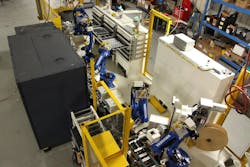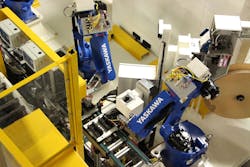The COVID-19 pandemic has impacted businesses around the world by disrupting supply chains, impacting cash flow and accelerating the pace of digital transformation. However, instead of dwelling on the negative aspects of the situation, it’s time to plan for the future. Companies need to develop a strategic comeback plan to guide them on the path of growth. Here are some recommendations to put businesses in the best future position.
Strategic Planning Advice
Economic slowdowns are a good time to prioritize projects that businesses never seem to find the time for. With this opportunity, owners should think about the opportunities that will be available on the other side of the slowdown and determine how to set themselves up for success. These four strategies can advance businesses post-pandemic:
- develop new products, applications and services
- standardize and improve business processes
- explore business transaction opportunities
- focus on short- and long-term cash forecasting.
Develop new products, applications and services
The slowdown in customer activity, combined with government programs, such as the U.S. Small Business Administration’s Paycheck Protection Program (PPP), intended to help employers to retain employees, means companies may have capacity to develop new products or services. Jose Rivera, CEO of the Control System Integrators Association (CSIA) shares how businesses are shifting toward automation amid COVID-19, not only to increase ROI, but also to save lives. The global pandemic revealed the supply chain’s sensitivity to disruption and the need for more automation solutions. “It is crucial for some industries to reduce the amount of employees on the manufacturing floor to abide by current COVID-19 guidelines,” Rivera says. “This creates new opportunities for systems integrators and manufacturers.”
Examine new applications for existing products: Out of necessity or otherwise, many companies are innovating to find new ways to use existing products. For example, Scott Manz, chief financial officer at Alliance Automation in Van Wert, Ohio, explains that COVID-19 is driving companies to think of the physical touch points within the manufacturing process and evaluate how robots can help to automate these processes going forward (Figure 1).
Figure 1: COVID-19 is driving companies such as Alliance Automation in Ohio to think of the physical touch points within the manufacturing process and evaluate how robots can help to automate these processes going forward.
Consider new products or product features: Businesses in a slowdown should take advantage of the opportunity to deploy engineering talent on developing new products while incorporating data analytics and artificial intelligence (AI) into existing products. “During this time we are asking engineers to focus on new technology and projects on our wish list so that we can come out of COVID-19 with new product offerings,” Manz says.
Leverage automation and data: Although the current environment has accelerated the need for automation, some companies were ahead of the curve. “Digital transformation was already taking place pre-COVID as part of Industry 4.0,” Rivera says. “Systems are becoming so intelligent that they will know how many umbrellas to produce simply based on rain forecast.” Rivera stresses the importance of data gathering to inform product development. “Systems integrators are good at gathering intelligence to get data out of systems,” he says. “This allows end users to understand the data and make more informed decisions.”
[javascriptSnippet ]
Standardize and improve business processes
Now is also a good time for businesses to refine and improve internal processes. This involves taking a closer look at three distinct, but equally important, areas of operations: product development, financial management and data analytics.
Product development: One way for systems integrators to add business savviness to technical teams and start streamlining product development processes is to adopt best practices and achieve certification, such as the CSIA certification. “If you want your company to be relevant in these rapidly changing times, you will implement best practices at all levels of the organization so this becomes part of the business’ DNA,” Rivera says. These best practices form the foundation for system-integrator processes, which helps promote better long-term performance.
While focusing on quality, companies have the added challenge of engaging and adapting to a mobile workforce as working remotely has become the new normal for many businesses. Alliance Automation went through a period where employees in sales, applications, engineering and purchasing collectively worked from home (Figure 2). Manz states, “This has allowed us to consider more flexible work arrangements long-term and has challenged leadership to find ways to continue to service our customers while complying with our governor’s efforts to protect the health of employees.” Effective communication and accountability in this new remote work environment are necessary to ensure the delivery of quality products and top-notch customer service.
Figure 2: Alliance Automation went through a period where employees in sales, applications, engineering and purchasing collectively worked from home.
Financial management: Streamlined financial-management procedures are key to running any successful business. Now, more than ever, it is important for businesses to regularly review cash flow and optimization to ensure the highest level of financial vitality. Maintaining a clear short- and long-term cash-flow picture can make managing the unexpected less painful. For those who may not have a robust management process in place, data analytics may offer solutions as they analyze existing data to uncover important sales, inventory, accounts receivable and customer segmentation information. Cash-flow planning is not only a valuable exercise when transitioning from survival to recovery, but it’s necessary to satisfy banks and other lenders that have issued loans or lines of credit. Although banks have offered some flexibility over the past few months, it will be critical to demonstrate how quickly the business can return cash to pre-COVID-19 levels. Including short- and long-term cash-flow plans that highlight when and how the business will be impacted throughout recovery is essential. Failing to provide such information to lenders may jeopardize available credit at a time when businesses need it most.
Data analytics: With the strategic plan set, it is important to measure and track performance against specific goals. Targeted data analytics can help to lay the groundwork for companies as they work to recover, adjust and strategize for the new normal. Businesses that leverage data analytics are better-suited to make well-informed and timely decisions about where their businesses currently are and where they need to go. Given the unpredictability of the pandemic and ever-changing guidelines, it is important to focus on forward-looking analysis to generate real insights. Businesses also need to analyze relevant external data to see the full picture. This can be done through modeling potential demand scenarios, creating multiple recovery plans incorporating key-performance-indicator (KPI) estimates and modeling to design strategies for operations within extreme situations .
KPIs are useful for evaluating the impact of implemented changes and include metrics, such as employee utilization, revenue by employee, day’s cash on hand, gross profit and gross margin. Evaluating these KPIs will help business owners to track financial performance and plan for recovery. Manz notes that Alliance Automation was in a good position going into COVID-19 because it has always focused on measurements and cash-flow scenario planning to prepare for emergencies like this (Figure 3).
Figure 3: Alliance Automation was in a good position going into COVID-19 because it has always focused on measurements and cash-flow scenario planning to prepare for emergencies.
Companies that follow this guidance will be one step closer to converting transactional data into actionable insights that will help them to plan for a variety of recovery scenarios.
Explore business transaction opportunities
If considering buying or selling a business at some point in the future, now is the time to prepare. Start defining aspirations, getting finances in order and taking the right steps forward.
Consider family-wealth transfers: Often, the best time to gift a portion of a company to children or other family members is when the value is low, states Sarah Russell, Clayton & McKervey shareholder and tax lead. Entrepreneurs are often hesitant to give up control or make a transfer to family members until they are sure that the company is going to thrive. Thus, it is important to monitor overall company value and consider timing gifts to occur prior to a transaction. When an owner decides to make a gift, the company must be valued, and the value may be set at a higher number if it is established by reference to a letter of intent or a consummated transaction, hence making transfers prior to transactions beneficial.
Acquisitions: Clearly, opportunities exist to acquire businesses from owners who aren't looking to survive another business cycle. Define motivations first to determine if acquisition is a good business decision. Understanding motivations, such as the desire to acquire a competitor to increase market share or add a complementary product line, is key. After outlining the business case, owners can use cash-forecasting and scenario-analysis tools to understand the impact of acquiring a business and determine the optimal transaction size.
Exit plan: Some business owners may view this slowdown as an indicator that it is time to move on. There are action steps to take today to maximize company value when taking a business to market. One essential strategy is to monitor net working capital (NWC) closely. This includes a company’s current assets—inventory, accounts receivable, prepaid expenses—in excess of its current liabilities—trade payables, accrued wages. Since NWC is what allows a company to operate on a daily basis, a buyer wants to make sure there is sufficient NWC to operate in the days immediately following a transaction. To accomplish this, the buyer will generally set a target for the NWC and agreements will require the buyer to pay for any excess NWC and require that the seller make up any NWC shortfall. This prevents sellers from altering the value of a company by driving down receivables or letting payables build up, in the days leading up to a transaction. If NWC is not properly managed in the years leading up to a sale, the seller could end up leaving significant value on the table. “As an owner looks to retire or transition the business, the books become vital. They need to tell a good story to position the company for top dollar in an acquisition,” Rivera says.
Baby-boomer retirement trends: With an eye on societal trends, owners can take advantage of some near-term opportunities to buy or sell a business. Looking at the numbers on a macro level can be strategic, if goals include purchasing complementary, or competitive, entities or to influence succession plans. For example, approximately 10,000 baby boomers turn 65 each day, and all of them will be 65 or older by 2030, according to the U.S. Census Bureau. More than 70% of the approximately 28 million small businesses will change hands in the near future. Up to 60% could be acquired by third parties. Succession planning is important to small businesses.
Retain key employees: As a company is growing, key employees will be brought onboard to take on management roles, help grow the company and add value. It is critical for a business to retain key individuals, especially when it is time to sell or enter into a transaction to obtain growth capital. Most businesses have at least one or two key employees who are disproportionally responsible for the success of the company. Hence, in the event of a future sale, the retention of these employees will become a point of concern to prospective buyers. One retention option is to implement a management equity plan. These plans vary widely and can include phantom ownership, actual ownership and ownership that vests over time or is based on performance. Another consideration is to provide retention bonuses, which are paid in addition to regular compensation and offered as an incentive to retain key employees during the selling process. Typically, the bonus is paid out by the seller when the transaction is finalized and is forfeited if the employee leaves prior to the sale. Phantom stock, a form of compensation that mirrors that of equity ownership, is another option to help retain employees. The arrangement pays out a cash reward based on the increase in value of the company over a period of time. At inception, an initial value is established and phantom units, or hypothetical stock, are used to track appreciation in value. One of the advantages, from an owner’s perspective, is that this strategy does not actually require any change in ownership structure.
Focus on short- and long-term cash forecasting
Regardless of their strategic objectives, businesses need to find ways to free up cash both to survive the downturn, as well as to accomplish long-term goals. Russell states this can be a challenge for systems integrators whose projects are typically based on fixed prices. It is important for companies to be more aggressive on terms to remain prosperous. Here are some opportunities to free up cash flow.
CARES Act: As the largest stimulus package in U.S. history, the CARES Act offers benefits to help businesses to free up cash flow and maximize tax planning. This involves the temporary repeal of certain provisions of the Tax Cuts and Jobs Act of 2017 (TCJA), including net operating losses, business loss limitation, limitation on business interest and technical corrections.
R&D tax credits: The research & experimentation tax credits, commonly known as the R&D tax credit, can have an immediate impact on a company’s cash position, as it frees up money that ordinarily would have been used to pay annual or estimated taxes, Russell says. Owners can also use those savings to reinvest in the operation. Due to the many positive impacts, businesses would benefit from investigating whether they qualify for the credit. Companies in the technology, industrial-automation, machine-building and tool-and-die-making industries are often candidates. Alliance Automation, for example, was able to maximize its advantage of R&D tax credits by taking a deeper look at qualified activity and related costs, increasing the credit from approximately $100,000 to $350,000. Alliance was also able to reevaluate the structure of the organization to ensure all owners were able to benefit from the credit, states Manz.
- Leveraging tax savings: When quoting new projects, few companies take into consideration the potential tax savings that would be available if the project qualifies for the R&D credit. Russell states that these savings could be used as a built-in discount during the quoting stage of a project. This strategy could be a good option on jobs where there is stiff competition, to strategically attract a new customer or to defend an existing customer from a competitor.
- Reinvesting in the business: Businesses that account for the R&D credit in the annual budgeting process may be able to pull forward some investments, which could improve operational efficiency or capabilities. For example, Jim Miller, president and owner of Air and Liquid Systems (ALSI) in Rochester Hills, Michigan, sets aside a portion of the R&D savings into a bonus pool used to reward employees involved in the R&E activities. This program has resulted in increased revenues as more projects are completed during the year and with increased profitability.
Government loan programs: Many eligible small businesses took advantage of government loans through the PPP and Main Street Lending programs. Owners and CFOs need to understand these opportunities and the benefits they provide.
- Paycheck Protection Program (PPP): This program provides qualifying small businesses with federally guaranteed emergency loans for business interruption due to COVID-19.
- Main Street Lending: This program offers options for mid-market to upper-market companies that may not qualify for the PPP and includes a minimum loan ask of $250,000. Borrowers interested in these types of loans would apply through their banks, so many companies considering this option tend to be domestic middle-market clients with established lending relationships. This loan was also created under the 2020 CARES Act. Businesses that received support through the Paycheck Protection Program are eligible to receive loans through the Main Street Lending Program; however, there is no forgiveness portion to this loan. It is designed for companies with between 0 and15,000 employees and no more than $5 billion in revenue. This lending program comes with restrictions on officer compensation, stock repurchases and dividends as outlined in the CARES Act.
- Economic injury disaster loans (EIDLs): The CARES Act allows companies to apply for EIDLs due to COVID-19. Typically these loans are reserved for businesses located in an area of natural disaster. Loans are available up to $2 million with repayment terms determined by a company’s ability to repay the loan. These loans cannot be used for the same expenses as PPP funds and come with additional restrictions and potential personal guarantees.
- Local grants: Many local counties have grant funding available due to COVID-19 through funds allocated to local municipalities through the CARES Act. Stay abreast of what is available and apply for such funding if you meet the qualifications. These programs continue to increase on a weekly basis, so businesses need to make sure they are staying on top of what is out there.
Cost segregation: Business owners can take the benefit of real estate ownership to the next level by squeezing out future tax benefits now by completing a cost-segregation study. This involves identifying and separating tangible personal-property components and land-improvement costs from the lump-sum building cost. This tax-savings tool allows companies and individuals who have constructed, purchased or remodeled business property to increase cash flow by accelerating depreciation deductions and deferring federal and state income taxes.
It is important for businesses to keep these considerations in mind as they navigate the pandemic, implement new strategies and adapt to remote working environments. No one knows when things will be back to normal, but focusing on these best practices can help put businesses on a path of success.
ALSO READ: Money on the table: — Taking advantage of the R&E tax credit

Leaders relevant to this article:








